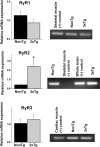Deviant ryanodine receptor-mediated calcium release resets synaptic homeostasis in presymptomatic 3xTg-AD mice
- PMID: 19641109
- PMCID: PMC6666542
- DOI: 10.1523/JNEUROSCI.2047-09.2009
Deviant ryanodine receptor-mediated calcium release resets synaptic homeostasis in presymptomatic 3xTg-AD mice
Abstract
Presenilin mutations result in exaggerated endoplasmic reticulum (ER) calcium release in cellular and animal models of Alzheimer's disease (AD). In this study, we examined whether dysregulated ER calcium release in young 3xTg-AD neurons alters synaptic transmission and plasticity mechanisms before the onset of histopathology and cognitive deficits. Using electrophysiological recordings and two-photon calcium imaging in young (6-8 weeks old) 3xTg-AD and non-transgenic (NonTg) hippocampal slices, we show a marked increase in ryanodine receptor (RyR)-evoked calcium release within synapse-dense regions of CA1 pyramidal neurons. In addition, we uncovered a deviant contribution of presynaptic and postsynaptic ryanodine receptor-sensitive calcium stores to synaptic transmission and plasticity in 3xTg-AD mice that is not present in NonTg mice. As a possible underlying mechanism, the RyR2 isoform was found to be selectively increased more than fivefold in the hippocampus of 3xTg-AD mice relative to the NonTg controls. These novel findings demonstrate that 3xTg-AD CA1 neurons at presymptomatic ages operate under an aberrant, yet seemingly functional, calcium signaling and synaptic transmission system long before AD histopathology onset. These early signaling alterations may underlie the later synaptic breakdown and cognitive deficits characteristic of later stage AD.
Figures









Similar articles
-
Early presynaptic and postsynaptic calcium signaling abnormalities mask underlying synaptic depression in presymptomatic Alzheimer's disease mice.J Neurosci. 2012 Jun 13;32(24):8341-53. doi: 10.1523/JNEUROSCI.0936-12.2012. J Neurosci. 2012. PMID: 22699914 Free PMC article.
-
Nitric oxide signaling is recruited as a compensatory mechanism for sustaining synaptic plasticity in Alzheimer's disease mice.J Neurosci. 2015 Apr 29;35(17):6893-902. doi: 10.1523/JNEUROSCI.4002-14.2015. J Neurosci. 2015. PMID: 25926464 Free PMC article.
-
NMDA-mediated Ca(2+) influx drives aberrant ryanodine receptor activation in dendrites of young Alzheimer's disease mice.J Neurosci. 2010 Sep 8;30(36):12128-37. doi: 10.1523/JNEUROSCI.2474-10.2010. J Neurosci. 2010. PMID: 20826675 Free PMC article.
-
RyR-mediated calcium release in hippocampal health and disease.Trends Mol Med. 2024 Jan;30(1):25-36. doi: 10.1016/j.molmed.2023.10.008. Epub 2023 Nov 11. Trends Mol Med. 2024. PMID: 37957056 Review.
-
Contribution of Ca2+ release channels to hippocampal synaptic plasticity and spatial memory: potential redox modulation.Antioxid Redox Signal. 2014 Aug 20;21(6):892-914. doi: 10.1089/ars.2013.5796. Epub 2014 Mar 11. Antioxid Redox Signal. 2014. PMID: 24410659 Review.
Cited by
-
Modeling presenilin-dependent familial Alzheimer's disease: emphasis on presenilin substrate-mediated signaling and synaptic function.Int J Alzheimers Dis. 2010 Jul 20;2010:825918. doi: 10.4061/2010/825918. Int J Alzheimers Dis. 2010. PMID: 20798900 Free PMC article.
-
Ryanodine receptors: physiological function and deregulation in Alzheimer disease.Mol Neurodegener. 2014 Jun 5;9:21. doi: 10.1186/1750-1326-9-21. Mol Neurodegener. 2014. PMID: 24902695 Free PMC article. Review.
-
Identification of tetrahydrocarbazoles as novel multifactorial drug candidates for treatment of Alzheimer's disease.Transl Psychiatry. 2014 Dec 16;4(12):e489. doi: 10.1038/tp.2014.132. Transl Psychiatry. 2014. PMID: 25514752 Free PMC article.
-
Ca2+ Dyshomeostasis Disrupts Neuronal and Synaptic Function in Alzheimer's Disease.Cells. 2020 Dec 10;9(12):2655. doi: 10.3390/cells9122655. Cells. 2020. PMID: 33321866 Free PMC article. Review.
-
Compound exposure of 2.8 GHz and 9.3 GHz microwave causes learning and memory impairment in rats.Heliyon. 2025 Jan 3;11(1):e41626. doi: 10.1016/j.heliyon.2025.e41626. eCollection 2025 Jan 15. Heliyon. 2025. PMID: 39866417 Free PMC article.
References
-
- Bardo S, Cavazzini MG, Emptage N. The role of endoplasmic reticulum calcium stores in the plasticity of central neurons. Trends Pharmacol Sci. 2006;27:78–84. - PubMed
-
- Berridge MJ. Neuronal calcium signaling. Neuron. 1998;21:13–26. - PubMed
-
- Bliss TV, Collingridge GL. A synaptic model of memory: LTP in the hippocampus. Nature. 1993;361:31–39. - PubMed
-
- Bouchard R, Pattarini R, Geiger JD. Presence and functional significance of presynaptic ryanodine receptors. Prog Neurobiol. 2003;69:391–418. - PubMed
MeSH terms
Substances
LinkOut - more resources
Full Text Sources
Other Literature Sources
Molecular Biology Databases
Research Materials
Miscellaneous
